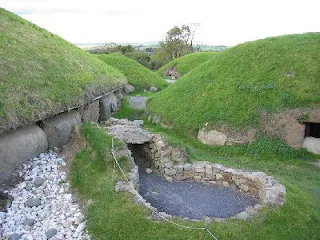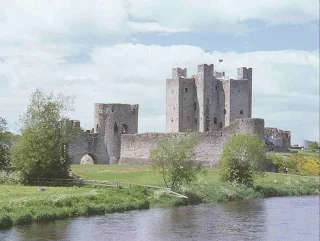 |
| Passage Grave at Knowth, Boyne Valley |
The Beginning
The first traces of Irish life can be found in the passage graves in the Boyne Valley at Dowth, Knowth and Newgrange dated at about 3000 BC. These are the graves of tribal kings of Neolithic agriculturalists, who are assumed to have arrived in Ireland from Neolithic Europe, via the island of Britain although recent research suggests they may have come from the Iberian Peninsula, spreading via the coast of modern France and southern England and Wales.They were invaders and were themselves replaced in turn by successive waves of invaders from Britain, France and Spain who brought bronze and iron. The last of these invaders were the Iron Age Celtic Gaels who brought with them the Gaelic language and Celtic traditions that were to become the distinguishing features of the Irish. They arrived in Ireland about 2000 years ago.
The island of Ireland remained almost completely free from Roman influence during Rome’s 400-year occupation of most of Britain. No Roman administrator is known to have set foot on Irish soil and, at the end of Roman rule in Britain, Ireland remained pagan, living by agriculture, raiding and fighting one another; a society of shifting alliances and changing patterns of power and influence
The traditional High Kings of Tara were not, in any modern sense, kings of a united people. Rather, they were holders of semi-sacred symbolic titles and had no law-making powers. Yet, despite this lack of a central authority the Irish tribes had a great deal in common. They spoke the same language and followed a common code (the Brehon Law). They shared a tradition of poetry and music and the same legendary history. One of the distinguishing features of Irish culture was, and is, its resilience.
The Coming of Christianity.
 |
| Illuminated page from the Book of Kells |
Vikings.
In AD 795 a second great shock occurred. An armada of open boats filled with strange warriors from unknown lands beached at Lambay Island off the Dublin Coast. The Vikings had arrived. They slaughtered, burned and ransacked their way into Irish life. More than a century later these ‘Danes’, who were mostly of Norwegian origins, were remembered as...immense floods and countless sea-vomiting of ships and fleets so there was not a harbour or landport in the whole of Munster without floods of Danes and pirate..."
 |
| Viking Invasion of the British Isles |
The Vikings settled and became part of Irish society in their turn. They built the coastal towns of Wexford and Arklow, and Dublin itself, and settled into the Gaelic pattern or warring kings.
Normans.
The next great shock was on 1 may 1170. A small group of Norman English, having set sail from Wales, landed at Baginbun in Southwest Wexford and established a bridgehead. From this bridgehead was to flow eight centuries of conflict.The leader of this band of Normans was a baron of the English King, the Earl of Pembroke, known as Strongbow. He had been invited by the King of Leinster, Dermot Macmurrough, who needed the superior Norman war technology of armour ad archery to fight his High King who’s own soldiers still used slings and stones. Strongbow captured Dublin for Macmurrough and as a reward was given Macmurrough’s daughter in marriage. When Macmurrough died, Strongbow became King of Leinster.
 |
| Trim Castle on the banks of the Boyne. Built by Hugh de Lacey between 1172 and 1224. |
The effect was immediate. Norman adventurers stormed into Ireland and devastated Gaelic society. They formed alliances with some chiefs and seized land and cattle from others. They built huge castles to protect their gains and penetrated into all parts of the island except the wild and remote central Ulster. They overwhelmed the Irish with their superior military technology and became, in effect, local kings. Though they owed nominal allegiance to the English Crown, they were acting in their own interests and English control was weak or non-existent.
 |
| Norman Ireland in 1300 |
In time, these invaders too, like the Vikings before them, became Irish in character, adopting Gaelic and intermarrying with the native people. They too settled into the Irish pattern of warring petty kings and adopted Gaelic Law. Numerous attempts were made by the English to stop this process of assimilation. An early Irish parliament at Kilkenny in 1366 tried to legislate against it by outlawing the wearing of Irish clothes, Irish hairstyles and the use of Irish laws by ‘the English born in Ireland’. It was to no avail. English influence shrank to almost non-existence to a small area around Dublin enclosed by defensive, isolating ramparts, known as ‘the Pale’. The term ‘beyond the Pale’ entered English to signify anyone whose behaviour cannot be coped with or controlled.


I wonder how a map of England in 1300 would look. I guess the (French) Normans would have owned a similar amount, or probably more.
ReplyDeleteThat helps me to realise that everything the English have been blamed for in Ireland was really the fault of the French all along.
Incidentally - whatever happened in previous centuries might have been genuinely unpleasant, but the ordinary people of England suffered similar privations at the hands of their 'lords and masters'.
I don't feel that I am personally to blame for any of it any more than I personally get the credit for the abolition of slavery. (I went to the same school as William Wilberforce.)
I can see you're a history buff Rosa. The power with how history is determined, is the ones telling that story. I can see why you frantically want to show history, from your perspective.
ReplyDeleteI can understand your concern that people might learn the truth of what other sanctimonious bigots did to people in earlier times when they weren't constrained by decent humanist laws like nowadays in civilised countries.
Delete